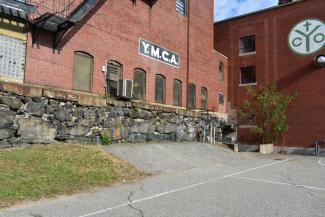Small but Mighty: Woonsocket’s Federal Street Historic District Earns Federal Designation
Published on Wednesday, October 30, 2024
(Woonsocket, RI) A cluster of six properties encompassing most of a city block in downtown Woonsocket has been recognized for its contributions to the community and architectural history of the city. Jeffrey Emidy, Executive Director of the Rhode Island Historical Preservation & Heritage Commission, announced that the National Park Service has added the Federal Street Historic District to the National Register of Historic Places. The National Register is the official list of places and objects of significance in American history, architecture, and culture.
The Federal Street Historic District is notable for its concentration of institutional properties, with its contributing buildings used for various religious, recreational, educational, and social functions. The District extends nearly the length of Federal Street, which was laid out between 1903 and 1911 to open new parcels for development as downtown Woonsocket expanded. Properties included in the Historic District designation are:
- JOSEPH GRENON’S GARAGE/STADIUM GARAGE/INTERNATIONAL TRADES UNION BUILDING (1925), 122 Clinton Street/53 Federal Street
- MASONIC TEMPLE (1929), 142 Clinton Street
- FIRESTONE SERVICES STORES, INC. (1930, additions ca. 1965), 160 Clinton Street
- FIRST METHODIST EPISCOPAL CHURCH (1907-08), 1 Federal Street
- YMCA (1910-11), 43 Federal Street
- WOONSOCKET COMMERCIAL SCHOOL/SCHOOL OF COMMERCIALSCIENCES/HILL COLLEGE (ca. 1923), 77 Federal Street
Together, the buildings along Federal and Clinton streets convey a sense of what Woonsocket must have been like in the early 20th Century. The new District differs from the largely commercial and governmental section of Woonsocket’s historic Main Street in that its uses were more focused on civic and social organizations. The YMCA, Masonic Temple, and Methodist Church were all constructed within two decades, between 1907 and 1929, and the Woonsocket Commercial School was constructed during this same period.
The coherent streetscape of the Federal-Clinton block and its tucked-away location give it a distinct character from the nearby Main Street corridor. While Main Street was densely built up with commercial buildings, residences, hotels, and a theatre during the 19th century – Federal Street was a secondary street that developed more deliberately several decades later.
That these six institutional buildings on Federal Street have endured a century of change is part of what makes them worthy of protection. This area of Woonsocket experienced considerable development during the 20th century, with many buildings razed over the years to make way for new construction and parking lots. With every passing decade, the carriage houses, livery stables, and blacksmiths’ shops of old Woonsocket were converted to new uses or disappeared altogether. Modern urbanites were traveling by electric trolley and taxi, and they were buying automobiles. In 1925, two new businesses – a Firestone Service store and an indoor parking garage connecting Federal and Clinton Streets – appeared in the District to serve this growing market. Joseph Grenon’s auto garage would later follow in the steps of its institutional neighbors to become the home of the International Trades Union and later a part of the Father Marot CYO Center.
As a whole, the collection of historic buildings along Federal Street exhibits a continuity of scale and function which is integral to the character of downtown Woonsocket. A complete copy of the National Register nomination, with supporting history and documentation, is available on the RIHPHC website.
Jeffrey Emidy, Executive Director of the Rhode Island Historical Preservation & Heritage Commission, comments: “As a Woonsocket native, I’m particularly happy to see these buildings recognized as the homes of institutions that have served generations of city families. That their listing will also facilitate the conversion of some of them for housing is an additional benefit that ensures their future presence as a reminder of our history.”
In addition to honoring a property or district for its contribution to local, state, or national history, listing on the National Register of Historic Places provides additional benefits. It results in special consideration during the planning of Federal or federally assisted projects and makes properties eligible for Federal and Rhode Island financial incentives for historic rehabilitation projects.
About Rhode Island Historical Preservation & Heritage Commission
The Rhode Island Historical Preservation & Heritage Commission is the state agency for historical preservation and heritage programs. The Commission operates a statewide historical preservation program that identifies and protects historic buildings, districts, structures, and archaeological sites. As the state office for historic preservation, the RIHPHC is responsible for reviewing and submitting Rhode Island nominations to the National Register. The Commission also develops and carries out programs to document and celebrate the rich cultural heritage of Rhode Island's people.
###
